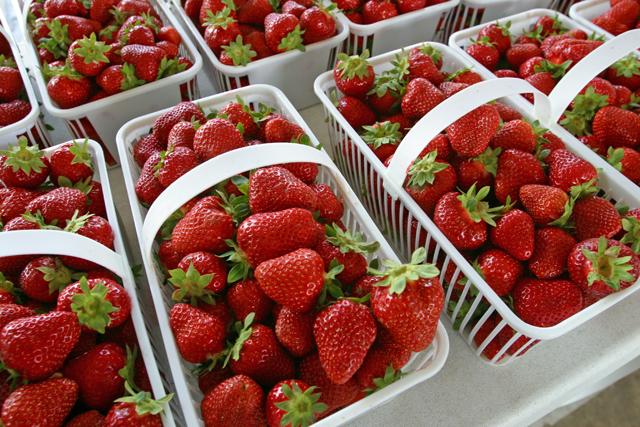
©
North Carolina strawberry production ranks number three in the United States and these red fruits provide lots of healthy vitamins and flavor. Photo courtesy of the North Carolina Strawberry Association.
Strawberry season is underway, and the little red fruit can have a big impact on North Carolina’s economy, as well as people’s health. The health benefits of eating more fruit have been proven by scientists and nutritionists, and strawberries are a good source of nutrients.
In North Carolina, strawberry farms are advocating to open to the public in order to provide fresh handpicked strawberries to local residents.
These farms are an important part of North Carolina’s agriculture industry.
According to Debby Wechsler from the North Carolina Strawberry Association, North Carolina produces a large portion of strawberry harvests on a national level.
“North Carolina’s actually the third largest producer in the country, if you [measure] by the value of the crop,” Wechsler said.
However, Wechsler said the distinction can be a bit misleading.
“But, that has to be taken with a grain of salt, because the number one and number two producers are way bigger than we are,” Wechsler said. “Together they produce something like 95 percent of the country’s strawberries. California is the biggest [producer], then Florida.”
Despite the small percentage of production on a national scale, Wechsler said the strawberry industry plays a big role in North Carolina’s economy.
“In terms of the contribution to North Carolina’s economy, it’s around 24 million dollars,” Wechsler said.
According to a USDA report, North Carolina produced approximately 19.5 million pounds of strawberries in 2010, creating a farm income of approximately 24.3 million dollars.
According to Wechsler, N.C. State has acted as a key influence on strawberry production in the state industry.
“N.C. State has been a real leader in strawberries for the whole region,” Wechsler said. “The University has had a really strong program of research and extension involving strawberries since the mid 1980s.”
The main method for production throughout the southeast is the plasticulture method developed at NC State. This method employs plastic as a substitute for mulch and uses a network of plastic irrigation tubing.
“[Plasticulture] has been adopted by growers in Georgia, South Carolina, Virginia and Ohio,” Wechsler said. “They’re all following the lead of North Carolina, and they all turn to North Carolina because the research on strawberries isn’t as strong in their states. We’ve got the plant pathologist, we have the horticultural expertise to do the research, to get information out and to share it throughout the region.”
Aside from being good for the local economy, strawberries also have certain health benefits.
Strawberries are healthy because they are a source of essential nutrients, according to Gabriel Harris, professor of food, bioprocessing and nutrition sciences.
“Strawberries contain relatively high levels of vitamin C, potassium and folates,” Harris said. “These are nutrients we have to consume because our bodies don’t make them on their own.”
According to Harris, strawberries have ellagic acid and anthocyanins, the chemical that makes them red, which are considered nonessential nutrients. In essence, they are beneficial for good health but not absolutely necessary for life.
“What needs further investigation are these nonessentials,” Harris said. “Potential benefits include high antioxidant properties, and potential anticancer effects.”
There may also be a benefit with regards to age related decline in cognitive functions, according to Harris.
However, the key word here is potential. According to Harris, while the benefits of vitamins and essential nutrients found in strawberries are known, the benefits of nonessential nutrients are still being researched.
“These benefits are not conclusive,” Harris said. “They are still actively being investigated.”
Jennifer Pries, senior in English and plant pathology, said she buys strawberries from the farmers’ market on the brickyard.
“When they’re in season, I buy them about once a week,” Pries said. “It’s wonderful to have a place where you can get them early.”
The strawberries come from a farm in Pender County, near Wilmington, according to Garry Wise, vendor at the campus farmers’ market.
“These strawberries are grown in a tunnel in Pender County,” Wise said.
The tunnels protect the strawberries from the elements, allowing for an early harvest.
To find a strawberry farm in your location, the N.C. Strawberry Association has a farm locator on their website, www.ncstrawberry.org.